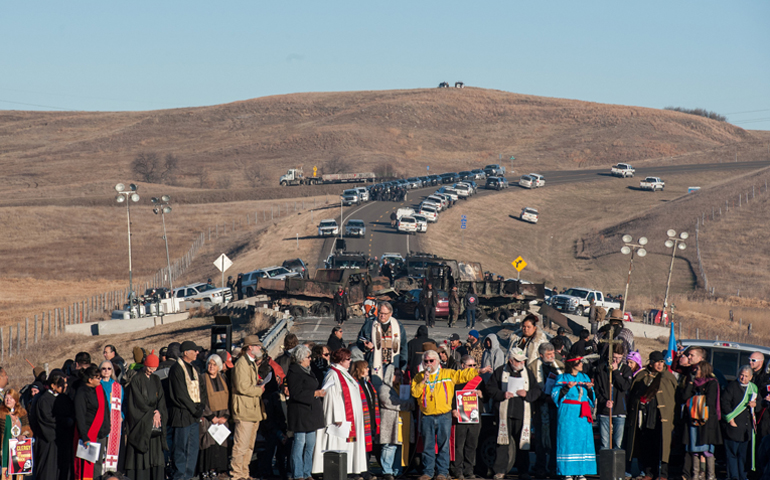
Clergy of many faiths from across the United States participate in a prayer circle Nov. 3, 2016 in Standing Rock, N.D., where demonstrators confront police during a protest of the Dakota Access Pipeline. (CNS/Stephanie Keith, Reuters)
I am a member of the Sisters of Loretto. Our formal title is Sisters of Loretto at the Foot of the Cross. And our earlier name was Friends of Mary at the Foot of the Cross. We don't tend to use the formal title. It harkens back to an 18th-century spirituality that can distract the people we work with from the tasks at hand of peace and justice. But we celebrate on Sept. 15 Mary's seven sorrows, and we do often remind ourselves that Loretto Community members, vowed members and co-members, are Friends of Mary. We say in an annual commitment celebration that "We are friends of Mary and friends to one another, committed to following the Gospel."
Back in the '80s, when Witness for Peace was sending delegations to Nicaragua to support the Sandanista revolution, a delegation was kidnapped by the Contras, the U.S.-armed opposition. Two members of the St. Louis Catholic Worker Community lived in Nicaragua then and were accompanying the Witness for Peace delegation. About a hundred protesters gathered in midtown St. Louis on the steps of St. Louis University's church, standing in solidarity in the hot sun and praying for the safety of our friends (who were eventually released).
Standing there that day, my understanding deepened of what it means to stand with Mary at the Foot of the Cross. I knew the concept of political solidarity and I had stood by then in plenty of picket lines for farmworkers, nuclear disarmament and an end to the death penalty. But this day, my heart was with my friends, Virginia and Mary. I stood with them, wherever they were, whatever was happening to them.
It was this experiential knowledge of "standing with" that grew in me that day. It changed how I bring myself to protests; it gave me an appreciation of the power we have when we stand in solidarity, in the presence of those who suffer.
Louise Erdrich has an article in the Dec. 22, 2016, issue of The New Yorker entitled "Holy Rage," about the presence of protesters at Standing Rock. It reminded me of myself, standing in opposition, over and over. Erdrich was not talking about the Foot of the Cross, but she was talking about a solidarity that is sacred because it is rooted in love.
When we march, the day after the president's inauguration, we will be standing with the water protectors at Standing Rock and in Flint, Mich. We will be sorrowing with mothers whose children are dead. We will be crying out for justice. We will be standing with Mary at the Foot of the Cross.




